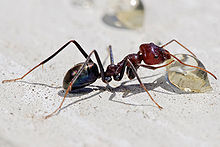| Dolichoderinae | |
|---|---|

| |
| Iridomyrmex purpureus feeding on honey | |
| Scientific classification | |
| Domain: | Eukaryota |
| Kingdom: | Animalia |
| Phylum: | Arthropoda |
| Class: | Insecta |
| Order: | Hymenoptera |
| Family: | Formicidae |
| Subfamily: | Dolichoderinae Forel, 1878 |
| Type genus | |
| Dolichoderus Lund, 1831
| |
| Diversity[1] | |
| 48 genera | |
Dolichoderinae is a subfamily of ants, which includes species such as the Argentine ant (Linepithema humile), the erratic ant, the odorous house ant, and the cone ant. The subfamily presents a great diversity of species throughout the world, distributed in different biogeographic realms, from the Palearctic, Nearctic, Afrotropical region and Malaysia, to the Middle East, Australian, and Neotropical regions.[2]
This subfamily is distinguished by having a single petiole (no post-petiole) and a slit-like orifice, from which chemical compounds are released. Dolichoderine ants do not possess a sting, unlike ants in some other subfamilies, such as Ponerinae and Myrmicinae, instead relying on the chemical defensive compounds produced from the anal gland.[3]
Of the compounds produced by dolichoderine ants, several terpenoids were identified including the previously unknown iridomyrmecin, isoiridomyrmecin, and iridodial.[4] Such compounds are responsible for the smell given off by ants of this subfamily when crushed or disturbed.[citation needed]
- ^ Bolton, B. (2015). "Dolichoderinae". AntCat. Retrieved 4 January 2015.
- ^ Cardoso, D.; Cristiano, M. P.; Barros, L. S.; Lopes, D.; Pompolo, S. (2012). "First cytogenetic characterization of a species of the arboreal ant genus Azteca Forel, 1978 (Dolichoderinae, Formicidae)". Comparative Cytogenetics. 6 (2): 107–14. doi:10.3897/CompCytogen.v6i2.2397. PMC 3833797. PMID 24260655.
- ^ Fisher, Brian L. and Stefan P. Cover (2007) Ants of North America: a guide to the genera
- ^ Wilson, E. O.; Pavan, M. (1959). "Glandular Sources and Specificity of Some Chemical Releasers of Social Behavior in Dolichoderine Ants". Psyche: A Journal of Entomology. 66 (4): 70. doi:10.1155/1959/45675.